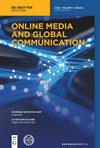谁是传播期刊的 "精英"?金砖五国大学参与顶级刊物的情况
引用次数: 0
摘要
尽管越来越多的研究涉及去西方化媒体研究的相关性,但我们缺乏对全球南方大学在传播领域最负盛名领域的表现的比较评估。在此背景下,本文探讨了金砖国家学者在顶级期刊上发表的文章是否以及在多大程度上仅限于少数学术机构——使他们成为被授权参与主流知识辩论的国家“精英”。我们提出三个问题:RQ1)金砖国家在传播领域的学术成果在多大程度上集中在少数几个“顶级”机构中?RQ2)在SJR数据库的期刊排名中,来自最具生产力大学的研究论文是如何分布的?问3)金砖国家的科研机构在撰写科研论文时参与了哪些伙伴关系?该实证研究使用了来自SciVal(爱思唯尔)和SJR (SCImago期刊排名)平台的数据,涵盖了2012年至2021年间发表的一系列文章。我们的研究结果显示,南非、俄罗斯和巴西在少数几所大学的学术成果集中程度最高。生产力最高和最低的大学之间的差异可以归因于在学术创新方面缺乏雄心勃勃的政策。当我们考虑中国的表现时,这种对比变得更加明显——中国实施了一系列战略来促进与西方学术界的国际伙伴关系。实际影响/社会影响我们认为,“去西方化”的要求必须超越仅仅要求增加人数代表的要求。对发展中地区的观点或现象的排斥阻碍了知识生产本身的进步。一旦社会科学和人文科学传统上在资助方面占据边缘地位,就好像全球南方的传播研究人员是“边缘的边缘”的一部分。原创性/价值这篇论文有助于我们讨论南半球大学的国际嵌入和影响半边缘社区学术贡献的动态。我们还考虑了SciVal和SJR指标在多大程度上强化了支持新自由主义全球化机制和学术议程标准化的学术理论基础。本文章由计算机程序翻译,如有差异,请以英文原文为准。
Who navigates the “elite” of communication journals? The participation of BRICS universities in top-ranked publications
Abstract Purpose Despite the increasing volume of research addressing the relevance of de-Westernizing Media Studies, we lack a comparative evaluation of the performance of Global South universities regarding their presence in the most prestigious domains within the field of Communication. Against this background, the article explores if and to what extent the publication of articles authored by BRICS-based scholars in top-ranked journals is restricted to a handful of academic institutions – making them a national “elite” authorized to engage in the mainstream intellectual debate. Design/methodology/approach We pose three questions: RQ1) To what extent is the academic output of BRICS countries in the field of Communication concentrated within a select few “top-level” institutions? RQ2) How are the research articles from the most productive universities distributed across the journal rankings comprising the SJR database? RQ3) What partnerships do institutions from BRICS countries engage in when producing research articles? Using data from the SciVal (Elsevier) and SJR (SCImago Journal Rank) platforms, the empirical study encompasses a set of articles published between 2012 and 2021. Findings Our findings reveal that South Africa, Russia, and Brazil had the highest concentration of academic production within a select few universities. The disparities among the most and least productive universities can be attributed to a lack of ambitious policies in terms of academic innovation. The contrast becomes more evident when we consider China’s performance – which has implemented a range of strategies to foster international partnerships with Western academic communities. Practical implications/social implications We contend that the demand for “de-Westernization” must go beyond a mere plea for increased numerical representation. The exclusion of perspectives or phenomena from developing regions hinders the progress of knowledge production itself. Once Social and Human Sciences traditionally occupy a peripheral position in terms of funding, it is as if Communication researchers based in the Global South were part of a “periphery of the periphery.” Originality/value The paper is relevant for enabling us to discuss Global South universities’ international insertion and the dynamics influencing the academic contributions of semi-peripheral communities. We also consider to what extent the SciVal and SJR metrics reinforce an academic rationale that upholds the mechanisms of neoliberal globalization and the standardization of the scholarly agenda.
求助全文
通过发布文献求助,成功后即可免费获取论文全文。
去求助
来源期刊

Online Media and Global Communication
Communication, Media Studies, Internet Studies, International Studies, International Relations-
自引率
0.00%
发文量
0
期刊介绍:
Online Media and Global Communication (OMGC) is a new venue for high quality articles on theories and methods about the role of online media in global communication. This journal is sponsored by the Center for Global Public Opinion Research of China and School of Journalism and Communication, Shanghai International Studies University, China. It is published solely online in English. The journal aims to serve as an academic bridge in the research of online media and global communication between the dominating English-speaking world and the non-English speaking world that has remained mostly invisible due to language barriers. Through its structured abstracts for all research articles and uniform keyword system in the United Nations’ official six languages plus Japanese and German (Arabic, Chinese, English, French, Russian, Spanish, Japanese, and German), the journal provides a highly accessible platform to users worldwide. Its unique dual track single-blind and double-blind review system facilitates manuscript reviews with different levels of author identities. OMGC publishes review essays on the state-of-the-art in online media and global communication research in different countries and regions, original research papers on topics related online media and global communication and translated articles from non-English speaking Global South. It strives to be a leading platform for scientific exchange in online media and global communication.
For events and more, consider following us on Twitter at https://twitter.com/OMGCJOURNAL.
Topics
OMGC publishes high quality, innovative and original research on global communication especially in the use of global online media platforms such as Facebook, TikTok, YouTube, Twitter, Instagram, WhatsApp, Weibo, WeChat, Wikipedia, web sites, blogs, etc. This journal will address the contemporary concerns about the effects and operations of global digital media platforms on international relations, international public opinion, fake news and propaganda dissemination, diaspora communication, consumer behavior as well as the balance of voices in the world. Comparative research across countries are particularly welcome. Empirical research is preferred over conceptual papers.
Article Formats
In addition to the standard research article format, the Journal includes the following formats:
● One translation paper selected from Non-English Journals that with high quality as “Gems from the Global South” per issue
● One review essay on current state of research in online media and global communication in a country or region
 求助内容:
求助内容: 应助结果提醒方式:
应助结果提醒方式:


